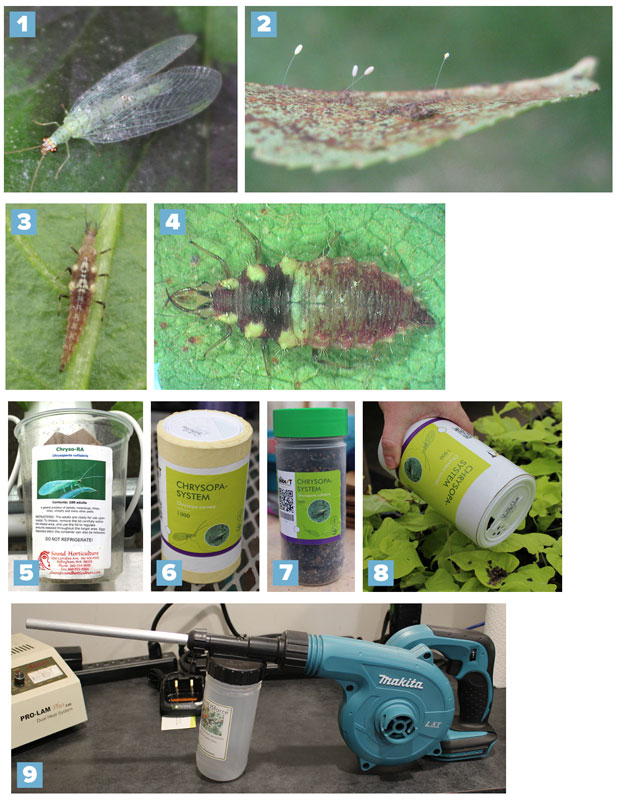6/1/2024
Green Lacewings: Biological Control Agents of Greenhouse Insect Pests
Dr. Raymond A. Cloyd

The green lacewings (Chrysopa carnea and Chrysoperla rufilabris) are predatory insects that can be released into greenhouse production systems to manage insect pest populations below plant-damaging levels on ornamental and vegetable crops. This article discusses the biology and behavior, commercial availability, and use of green lacewings as biological control agents in greenhouses.
Biology & behavior
Green lacewings have four life stages: egg, larva, pupa and adult. Adults are 3/4 of an inch (19 millimeters) in length, light green, with lacy wings held rooflike over the body when not flying and two brown eyes (Figure 1). Adults primarily feed on honeydew (clear, sticky liquid produced by aphids during feeding), and the pollen and nectar of flowering plants. Adults fly mostly at night. After mating, females lay eggs on the ends of hairlike, silken stalks attached to the topside or underside of plant leaves (Figure 2). The stalks protect the eggs from being fed upon by newly emerged (eclosed) larvae. A single female can lay between 400 and 500 eggs in three to four weeks. At 75F (24C) adults live between 20 and 40 days.
Larvae emerge (eclose) from eggs after approximately five days. There are three larval instars (stages between each molt). Larvae are 3/8 to 1/2 of any inch (9 to 12 millimeters) long and light brown (Figure 3). They have white lines or rows of black, brown or red spots extending the length of the body. Large, sickle-shaped mouthparts protrude from the head (Figure 4).
Figure 1. Adult green lacewing. ■ Figure 2. Green lacewing eggs on silken stalks. ■ Figure 3. Green lacewing larva. ■ Figure 4. Closeup of green lacewing larva. ■ Figure 5. Container of green lacewing eggs and adults. ■ Figure 6 & 7. Container of green lacewing larvae. ■ Figure 8. Releasing green lacewing larvae.
■ Figure 9. Mechanical blower used to apply green lacewing larvae throughout the greenhouse.
Green lacewing larvae feed on many species of aphids, consuming between 300 and 400 aphids over a two-week period. Although larvae prefer to feed on aphids, they also feed on mealybugs, mites, thrips, whiteflies, small caterpillars and moth eggs. Larvae grasp prey with their mouthparts, lift them up and inject a toxic saliva that dissolves the prey’s body. The larvae consume the dissolved body fluids. Larvae feed for two to three weeks and will eat (cannibalize) each other if no prey are available.
Plant leaves with hairs, or trichomes, hinder the ability of green lacewing larvae to locate prey. In addition, larvae that are moving around may cause aphids to drop off plants. After two to three weeks, green lacewing third instar larvae construct silken, white cocoons that are attached to the topside or underside of leaves. Adults emerge (eclose) from pupae in 10 to 14 days.
Development time of the life cycle, from egg to adult, varies depending on temperature. For example, the life cycle can be completed in 69 days at 60F (16C), 35 days at 70F (21C) and 25 days at 82F (28C). Development is slow when the temperature is above 95F (35C). The optimal conditions for reproduction are a temperature of 68F (20C), relative humidity of 80% and 15- to 17-hour daylength.
Commercial availability and use in greenhouses
Green lacewings are commercially available from biological control distributors and suppliers as eggs, larvae or adults in sealed containers (Figures 5 through 7). Place containers with green lacewing eggs or adults near localized aphid infestations. Larvae mixed with a buckwheat hull carrier can be distributed onto plant leaves (Figure 8). Lightly mist plant leaves with water before distributing green lacewing larvae so the larvae do not fall off plants. Green lacewing larvae can also be mixed with sawdust or bran and applied with a mechanical blower (Figure 9). GT
Dr. Raymond A. Cloyd is a Professor of Extension Specialist in Horticultural Entomology/Plant Protection at Kansas State University. He can be reached at (785) 532-4750 or rcloyd@ksu.edu.